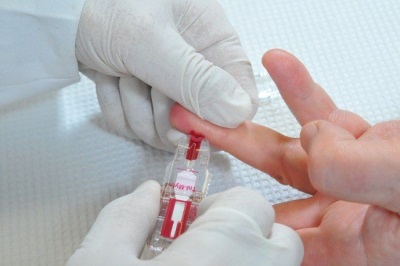Blood test for clotting and decoding of a baby coagulogram
To determine how the child coagulates and whether everything is in order with the stopping of bleeding and the formation of blood clots, a special analysis is prescribed, which is called a “coagulogram”.
What is it?
A coagulogram is a study of blood clotting, that is, the ability of the blood to stop the bleeding in case of damage to the vessel through the formation of a clot covering the place with impaired integrity.
Indications
Coagulogram prescribed in the following cases:
- If a child is suspected hemophilia, for example, he often has long-lasting bleeding.
- If the child has surgery. It is important to ensure that the coagulation system is working properly and surgical manipulation does not end with extensive bleeding.

Where to take the analysis?
You can donate a baby’s blood sample for coagulation at any medical facility that has reagents and equipment for this study. Such an analysis is done in the clinic, hospital, private laboratory, large medical center and other places.
Training
Delivery of this analysis requires compliance with certain rules:
- Blood should be donated in the morning, because during the day, indicators may change under the influence of many factors.
- The day before the analysis, the amount of food consumed should be reduced, and for eight to twelve hours to eat nothing, and also not to drink tea, juice and other sweet drinks. You can only drink clean water.
- Before manipulation, the child must be calm. The pulse of the baby should be within normal limits.
- Advise your baby in advance that he will take blood from a vein. Say that there will be practically no pain, and the procedure itself will pass very quickly.
If you give your child any medications that can affect the process of blood clotting, or your baby has had surgery and blood transfusions in the past, be sure to warn the doctor who will decipher the analysis.
Immediately after the manipulation, it is not necessary to strain the arm from which the blood sample was taken for about an hour.
Values of the norm and interpretation of the analysis
|
Indicator |
Its meaning |
Norm in childhood |
|
Platelets |
Blood cells involved in clotting and blood clots. |
From 131 to 402 thousand in 1 μl |
|
Clotting time |
The time from the beginning of the appearance of blood from the wound to the appearance of a fibrin clot. |
4 to 9 minutes |
|
Fibrinogen |
Protein synthesized in the liver. They under some conditions become fibrin, forming a thrombus. |
From 5.9 to 11.7 μmol / l |
|
Thrombin time |
The time interval during which fibrin is formed from fibrin. |
30 minutes (tolerance 3 minutes) |
|
Fibrinogen b |
In the blood of a healthy child such a protein is not detected. |
Missing |
|
Prothrombin Index (PTI) |
Ratio as a percentage of the time for which the process of clotting a blood sample of a healthy baby and the blood sample under investigation is performed. |
From 70 to 100% |
|
APTTV |
The abbreviation stands for "activated partial thromboplastin time." This indicator represents the time when a clot forms when mixing plasma with other substances, for example, with calcium chloride. |
24-35 seconds |
|
D-dimer |
It is a product resulting from the breakdown of fibrin.It shows how the process of formation of a blood clot. |
From 33 to 726 ng / ml |
|
Antithrombin III |
A protein that slows blood clot formation. |
From 70 to 115% |
|
Lupus anticoagulant |
Antibodies to the membranes of platelets. |
Missing |
|
Fibrinolytic activity |
The period of time during which the formed blood clot independently dissolves in the child’s blood. This process depends on a sufficient amount of fibrinolysin. |
180 to 260 seconds |
|
AVR |
Under this abbreviation, the “activated recalcification time” is encrypted. This is the name of the time period during which the plasma coagulates with the addition of calcium chloride. |
50 to 70 seconds |
|
Duke bleeding duration |
Estimation of the rate at which capillary bleeding stops. |
Less than 4 minutes |
|
Recalcification time plasma |
Estimation of the coagulation duration of oxalate plasma and citrate plasma using calcium chloride. |
90 to 120 seconds |
|
Trombotest |
Indicates enough presence of fibrinogen in the baby’s blood. |
IV-V degree |
|
Heparin Plasma Tolerance |
Shows how much thrombin is in the baby’s blood. |
3 to 11 minutes |
|
Fibrinogen concentration |
The indicator that determines the content of this protein in a liter of blood. |
From 1.25 to 4 g / l |
|
RFMK |
This abbreviation means "soluble fibrin monomeric complexes". The indicator allows to evaluate the processes of blood coagulation inside the vessels. |
Not more than 4 mg per 100 ml |
Causes of deviations
- An increase in the amount of prothrombin indicates the risk of blood clots. Prothrombin in the child’s blood may be less if he has hypovitaminosis K or has used certain medications.
- In the child’s blood, fibrinogen will be less with liver disease, impaired hemostasis, vitamin C and vitamin B hypovitaminosis, steroid use and fish oil. The amount of fibrinogen increases in the postoperative period, as well as with burns, pneumonia and infectious diseases.
- A reduced thrombin time indicates an excess of fibrinogen in the blood. An increased figure may indicate renal failure or a genetic pathology in which there is a deficiency of fibrinogen.
- A reduced PTI indicates a significant risk of bleeding, and an increased one indicates a greater risk of thrombosis.
- The increased APTTV index is characteristic for a lack of vitamin K or for renal failure, as well as for hemophilia and 2-3 stages of the syndrome of DIC. A decrease in APTT occurs in the first phase of DIC syndrome.
- With a high concentration of fibrinogen in children, acute infections, thyroid malfunction, and tumor processes can be detected.
- If a blood clot dissolves more quickly during thrombotest, this indicates increased bleeding in a child.
- Shortened AVR may be an indication of the presence of thrombophilia. If this indicator is elevated, the risks of blood loss and heavy bleeding in a child are increased.
- The increase in plasma tolerance to heparin occurs in diseases of the liver, and decreases in the pathologies of the cardiovascular system, after surgery or in cancer tumors.
- Detection of lupus anticoagulant is possible with cancer processes, ulcerative colitis and other pathologies.
- Increased FPC in the blood is characteristic of increased clotting system activity (the risk of blood clots in the vessels), and a decrease is possible with heparin treatment.

Diagnosis of coagulation disorders
Problems with coagulation of blood are both congenital and acquired. They are manifested by increased bleeding and spontaneous formation of blood clots, depending on what component of the process of clotting the child lacks or too much.
Such diseases are diagnosed in the departments of hematology on the basis of the presence of clinical manifestations, examination, a survey of parents (learn family history) and blood tests.If a genetic mutation is suspected, then a genetic examination is also performed.
Treatment
Increased blood clotting is dangerous by the spontaneous formation of clots in blood vessels, which causes circulatory disorders and the formation of an embolus (a broken blood clot that will circulate in the baby’s blood). That is why it is important for children to prescribe the necessary drug treatment.
If the child’s condition is acute or severe, he is hospitalized and drugs are administered intravenously to dissolve blood clots.










